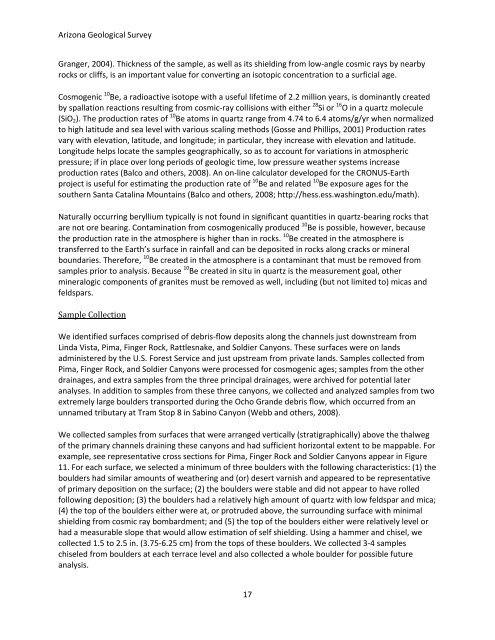Arizona Geological Survey OPEN-FILE REPORT OFR 08-06
Arizona Geological Survey OPEN-FILE REPORT OFR 08-06
Arizona Geological Survey OPEN-FILE REPORT OFR 08-06
You also want an ePaper? Increase the reach of your titles
YUMPU automatically turns print PDFs into web optimized ePapers that Google loves.
<strong>Arizona</strong> <strong>Geological</strong> <strong>Survey</strong><br />
Granger, 2004). Thickness of the sample, as well as its shielding from low‐angle cosmic rays by nearby<br />
rocks or cliffs, is an important value for converting an isotopic concentration to a surficial age.<br />
Cosmogenic 10 Be, a radioactive isotope with a useful lifetime of 2.2 million years, is dominantly created<br />
by spallation reactions resulting from cosmic‐ray collisions with either 28 Si or 16 O in a quartz molecule<br />
(SiO 2 ). The production rates of 10 Be atoms in quartz range from 4.74 to 6.4 atoms/g/yr when normalized<br />
to high latitude and sea level with various scaling methods (Gosse and Phillips, 2001) Production rates<br />
vary with elevation, latitude, and longitude; in particular, they increase with elevation and latitude.<br />
Longitude helps locate the samples geographically, so as to account for variations in atmospheric<br />
pressure; if in place over long periods of geologic time, low pressure weather systems increase<br />
production rates (Balco and others, 20<strong>08</strong>). An on‐line calculator developed for the CRONUS‐Earth<br />
project is useful for estimating the production rate of 10 Be and related 10 Be exposure ages for the<br />
southern Santa Catalina Mountains (Balco and others, 20<strong>08</strong>; http://hess.ess.washington.edu/math).<br />
Naturally occurring beryllium typically is not found in significant quantities in quartz‐bearing rocks that<br />
are not ore bearing. Contamination from cosmogenically produced 10 Be is possible, however, because<br />
the production rate in the atmosphere is higher than in rocks. 10 Be created in the atmosphere is<br />
transferred to the Earth’s surface in rainfall and can be deposited in rocks along cracks or mineral<br />
boundaries. Therefore, 10 Be created in the atmosphere is a contaminant that must be removed from<br />
samples prior to analysis. Because 10 Be created in situ in quartz is the measurement goal, other<br />
mineralogic components of granites must be removed as well, including (but not limited to) micas and<br />
feldspars.<br />
Sample Collection<br />
We identified surfaces comprised of debris‐flow deposits along the channels just downstream from<br />
Linda Vista, Pima, Finger Rock, Rattlesnake, and Soldier Canyons. These surfaces were on lands<br />
administered by the U.S. Forest Service and just upstream from private lands. Samples collected from<br />
Pima, Finger Rock, and Soldier Canyons were processed for cosmogenic ages; samples from the other<br />
drainages, and extra samples from the three principal drainages, were archived for potential later<br />
analyses. In addition to samples from these three canyons, we collected and analyzed samples from two<br />
extremely large boulders transported during the Ocho Grande debris flow, which occurred from an<br />
unnamed tributary at Tram Stop 8 in Sabino Canyon (Webb and others, 20<strong>08</strong>).<br />
We collected samples from surfaces that were arranged vertically (stratigraphically) above the thalweg<br />
of the primary channels draining these canyons and had sufficient horizontal extent to be mappable. For<br />
example, see representative cross sections for Pima, Finger Rock and Soldier Canyons appear in Figure<br />
11. For each surface, we selected a minimum of three boulders with the following characteristics: (1) the<br />
boulders had similar amounts of weathering and (or) desert varnish and appeared to be representative<br />
of primary deposition on the surface; (2) the boulders were stable and did not appear to have rolled<br />
following deposition; (3) the boulders had a relatively high amount of quartz with low feldspar and mica;<br />
(4) the top of the boulders either were at, or protruded above, the surrounding surface with minimal<br />
shielding from cosmic ray bombardment; and (5) the top of the boulders either were relatively level or<br />
had a measurable slope that would allow estimation of self shielding. Using a hammer and chisel, we<br />
collected 1.5 to 2.5 in. (3.75‐6.25 cm) from the tops of these boulders. We collected 3‐4 samples<br />
chiseled from boulders at each terrace level and also collected a whole boulder for possible future<br />
analysis.<br />
17
















